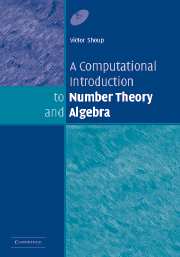Book contents
- Frontmatter
- Contents
- Preface
- Preliminaries
- 1 Basic properties of the integers
- 2 Congruences
- 3 Computing with large integers
- 4 Euclid's algorithm
- 5 The distribution of primes
- 6 Finite and discrete probability distributions
- 7 Probabilistic algorithms
- 8 Abelian groups
- 9 Rings
- 10 Probabilistic primality testing
- 11 Finding generators and discrete logarithms in
- 12 Quadratic residues and quadratic reciprocity
- 13 Computational problems related to quadratic residues
- 14 Modules and vector spaces
- 15 Matrices
- 16 Subexponential-time discrete logarithms and factoring
- 17 More rings
- 18 Polynomial arithmetic and applications
- 19 Linearly generated sequences and applications
- 20 Finite fields
- 21 Algorithms for finite fields
- 22 Deterministic primality testing
- Appendix: Some useful facts
- Bibliography
- Index of notation
- Index
Preliminaries
Published online by Cambridge University Press: 05 June 2012
- Frontmatter
- Contents
- Preface
- Preliminaries
- 1 Basic properties of the integers
- 2 Congruences
- 3 Computing with large integers
- 4 Euclid's algorithm
- 5 The distribution of primes
- 6 Finite and discrete probability distributions
- 7 Probabilistic algorithms
- 8 Abelian groups
- 9 Rings
- 10 Probabilistic primality testing
- 11 Finding generators and discrete logarithms in
- 12 Quadratic residues and quadratic reciprocity
- 13 Computational problems related to quadratic residues
- 14 Modules and vector spaces
- 15 Matrices
- 16 Subexponential-time discrete logarithms and factoring
- 17 More rings
- 18 Polynomial arithmetic and applications
- 19 Linearly generated sequences and applications
- 20 Finite fields
- 21 Algorithms for finite fields
- 22 Deterministic primality testing
- Appendix: Some useful facts
- Bibliography
- Index of notation
- Index
Summary
We establish here a few notational conventions used throughout the text.
Arithmetic with ∞
We shall sometimes use the symbols “∞” and “–∞” in simple arithmetic expressions involving real numbers. The interpretation given to such expressions is the usual, natural one; for example, for all real numbers x, we have -∞ < x < ∞, x + ∞ = ∞, x - ∞ = -∞, ∞ + ∞ = ∞, and (-∞) + (-∞) = -∞. Some such expressions have no sensible interpretation (e.g., ∞-∞).
Logarithms and exponentials
We denote by log x the natural logarithm of x. The logarithm of x to the base b is denoted logbx.
We denote by ex the usual exponential function, where e ≈ 2.71828 is the base of the natural logarithm. We may also write exp[x] instead of ex.
Sets and relations
We use the symbol ∅ to denote the empty set. For two sets A, B, we use the notation A ⊆ B to mean that A is a subset of B (with A possibly equal to B), and the notation A ⊆ B to mean that A is a proper subset of B (i.e., A ⊆ B but A ≠ B); further, A ∪ B denotes the union of A and B, A ∩ B the intersection of A and B, and A \ B the set of all elements of A that are not in B.
Information
- Type
- Chapter
- Information
- A Computational Introduction to Number Theory and Algebra , pp. xiv - xviPublisher: Cambridge University PressPrint publication year: 2005
